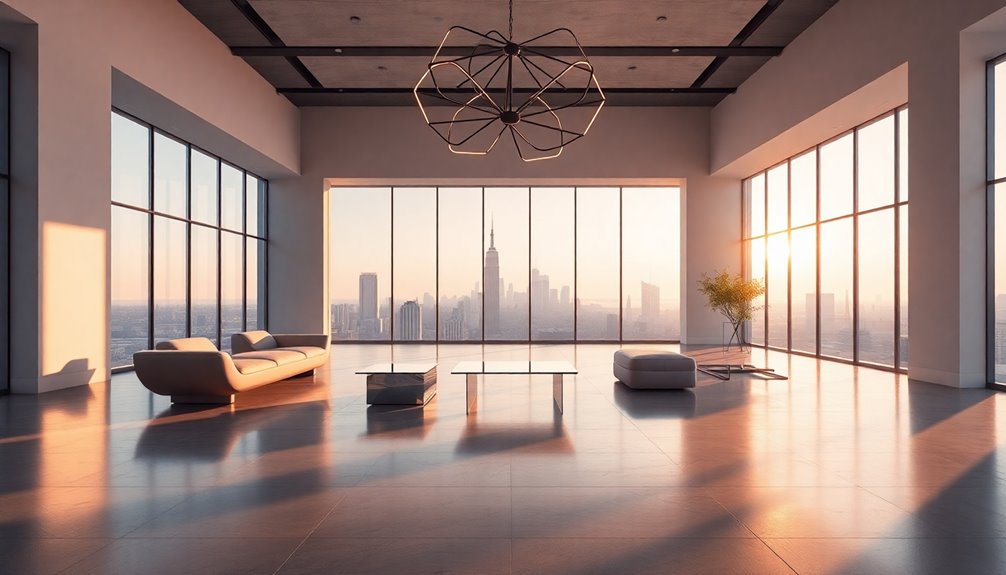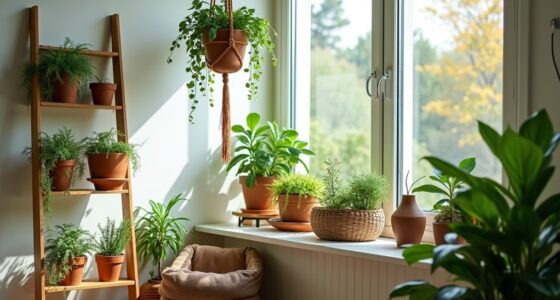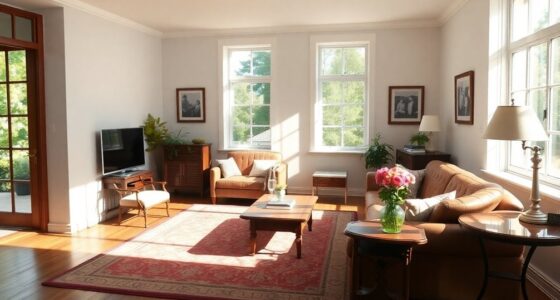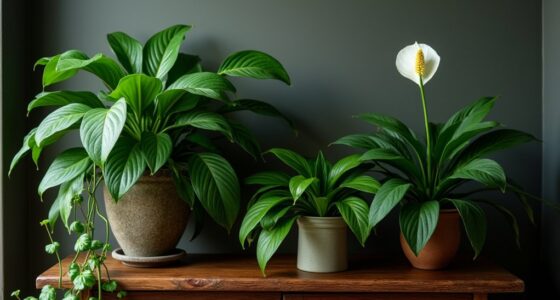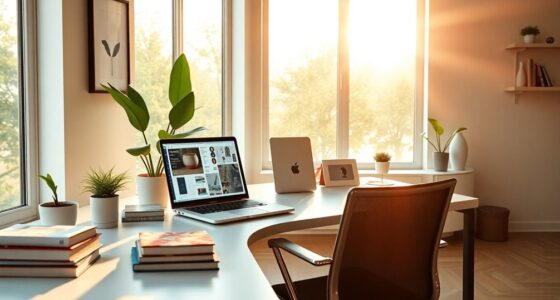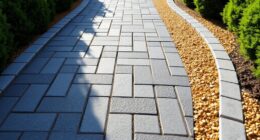Ultra-modern design is all about a sleek, futuristic style that combines minimalism with cutting-edge technology. You'll notice clean lines, open spaces, and ergonomic furnishings that prioritize function. This design approach uses high-tech materials like glass and steel, while embracing sustainable practices. Large windows and smart home tech create airy, efficient environments. Influenced by historical movements, ultra-modern design adapts traditional elements for contemporary needs and fosters community connections. It's a whole aesthetic that balances beauty and utility. If you're curious about specific examples and emerging trends, you'll want to explore further.
Key Takeaways
- Ultra-modern design emphasizes minimalism, featuring clean lines, open spaces, and a rejection of ornamentation for pure form.
- It utilizes high-tech and sustainable materials, integrating smart home technology for improved functionality and user experience.
- The design approach is rooted in the Bauhaus movement, blending traditional elements with contemporary needs for diverse architectural expressions.
- Focused on sustainability, ultra-modern design promotes resilience, biophilic principles, and modular construction to reduce environmental impact.
- Future trends include innovative materials like self-healing substances and the use of virtual reality in architectural design.
Key Principles of Ultra-Modern Design
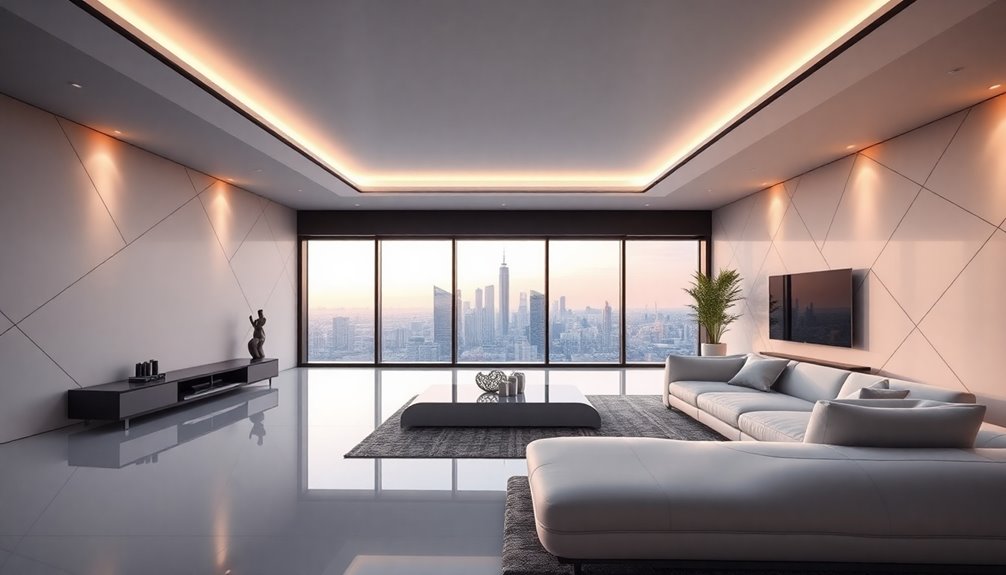
When it comes to ultra-modern design, the key principles revolve around creating harmonious and functional spaces.
You'll want to focus on blending living areas seamlessly, allowing for smooth movement between rooms through open layouts. Minimizing barriers and incorporating large windows will enhance natural light and visibility, making your space feel more expansive.
Prioritize comfort and usability by choosing ergonomic furniture and adjustable elements that cater to individual needs. Textures and cushioning can add a cozy atmosphere, while good acoustics promote relaxation. This approach reflects the principle that function is paramount, ensuring that your environment isn't only aesthetically pleasing but also a practical sanctuary that meets your lifestyle demands.
Embrace flexibility in layouts to adapt to your changing needs.
Characteristics of Ultra-Modern Spaces
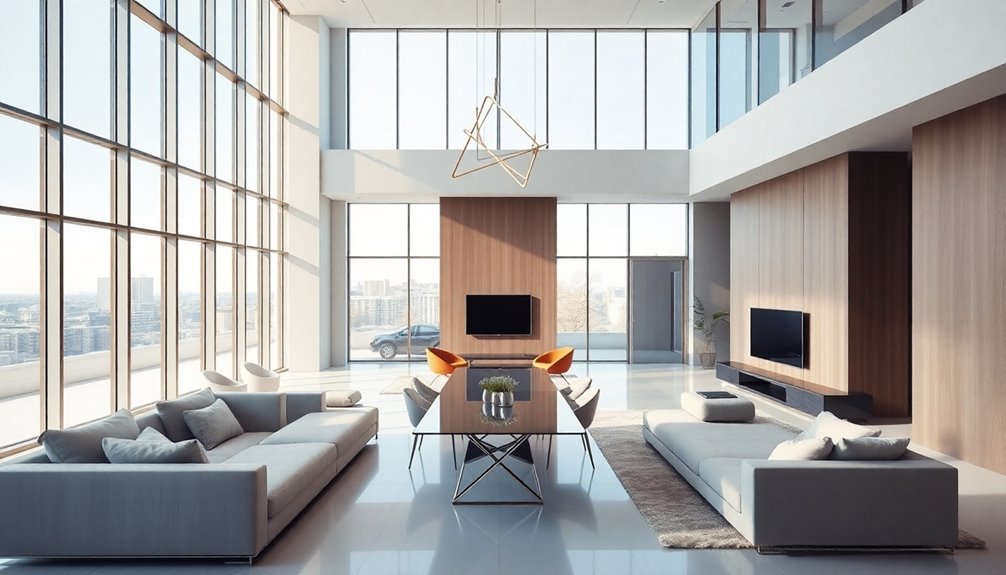
Ultra-modern spaces embody a distinct aesthetic that combines functionality with cutting-edge design.
You'll notice high-tech materials like metal, glass, and concrete, often paired with natural elements such as stone and wood. Sustainability is key, emphasizing eco-friendly choices. This architectural style also incorporates advanced technology to enhance both efficiency and livability.
Large windows and skylights maximize natural light, creating airy environments with open floor plans for free movement. The color palette leans toward neutrals, accented with earth tones or vibrant pops for depth.
Clean lines and minimalism dominate, ensuring that every piece serves a purpose. Geometric shapes and ergonomic designs enhance comfort while integrating natural surroundings.
This thoughtful approach results in spaces that are both visually striking and practical for everyday living.
Design Approaches in Ultra-Modern Design

While exploring design approaches in ultra-modern design, you'll quickly notice a strong emphasis on functionality and ergonomics. Every element serves a purpose, ensuring your space isn't only beautiful but also practical. Comfort is key, as living areas are designed with your wellbeing in mind. Integration with nature is another vital aspect; large windows connect interiors to the outdoors, while natural materials enhance the aesthetic. Additionally, the use of natural elements like stone and wood promotes a more inviting and human-centric space. Sustainability plays a crucial role too, with eco-friendly choices that reduce environmental impact. Finally, technology seamlessly merges with design, featuring high-tech materials and innovative solutions that elevate functionality. This holistic approach ensures your ultra-modern space feels both inviting and advanced, perfectly balancing style and substance.
Materials Used in Ultra-Modern Design
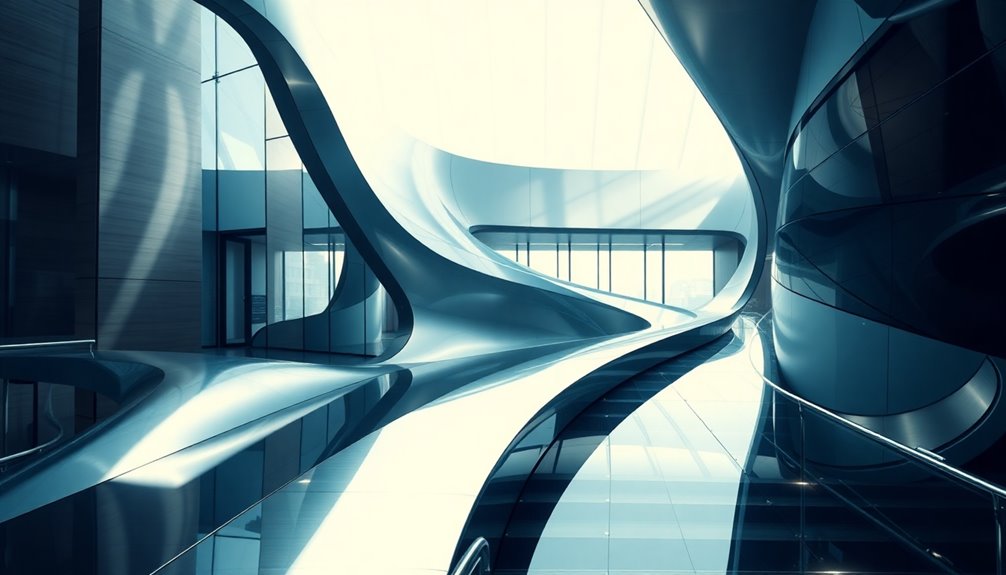
Design approaches in ultra-modern design prioritize not just aesthetics but also the materials that bring those visions to life.
You'll find high-tech materials like carbon fiber and transparent aluminum, offering strength while remaining lightweight. Metal and glass dominate, providing sleek, durable structures.
Sustainable options, such as Richlite and hemp reinforcement, reduce environmental impact without sacrificing quality. Advanced composites like aerogel and liquid granite enhance performance and versatility. Additionally, self-healing materials can significantly reduce repair costs by automatically repairing damage, ensuring longevity in ultra-modern designs.
Additionally, AI-augmented materials, including self-healing polymers and energy-generating facades, push the boundaries of innovation.
These materials not only create stunning designs but also address sustainability and functionality, ensuring that your ultra-modern spaces are both beautiful and practical.
Embracing these materials can elevate your design projects to the next level.
Examples of Ultra-Modern Design
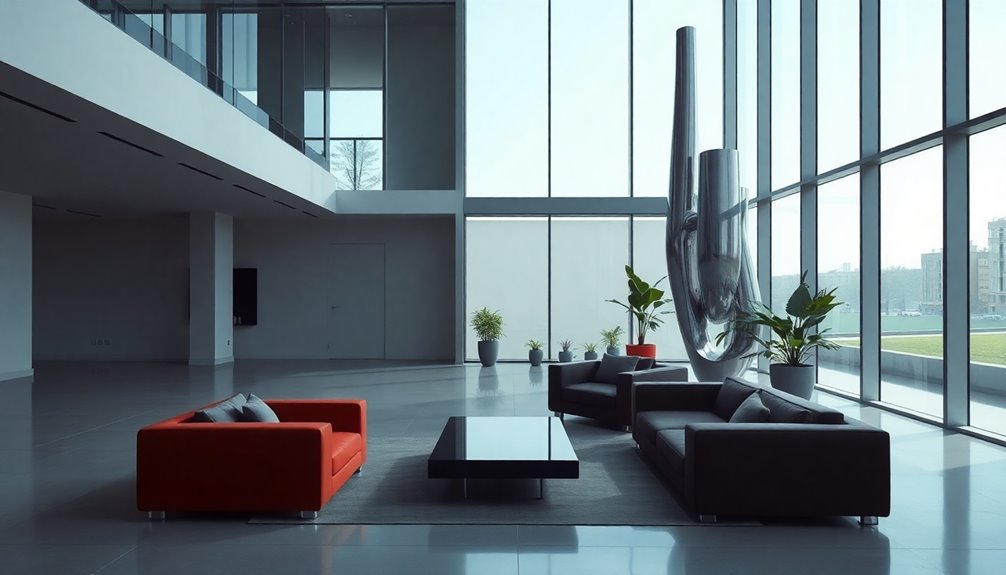
Numerous stunning examples showcase the essence of ultra-modern architecture, blending innovative materials and sustainable practices seamlessly.
The Crystal in East London features an all-glass design with six types of insulated glass and achieves 90% water self-sufficiency through rainwater harvesting. This building is notable for being the first commercial building in the UK with approved drinking water safety.
In Rio de Janeiro, the Museum of Tomorrow boasts solar "spines" that track the sun, maximizing energy absorption.
VIA 57 West in New York, with its unique distorted pyramid shape, incorporates a lush green courtyard reminiscent of Copenhagen's urban oases.
Finally, the Vancouver Convention Centre West stands out with the largest green roof in Canada, providing insulation and supporting local flora.
These buildings exemplify how ultra-modern design can harmonize aesthetics with environmental responsibility.
Practical Applications of Ultra-Modern Design
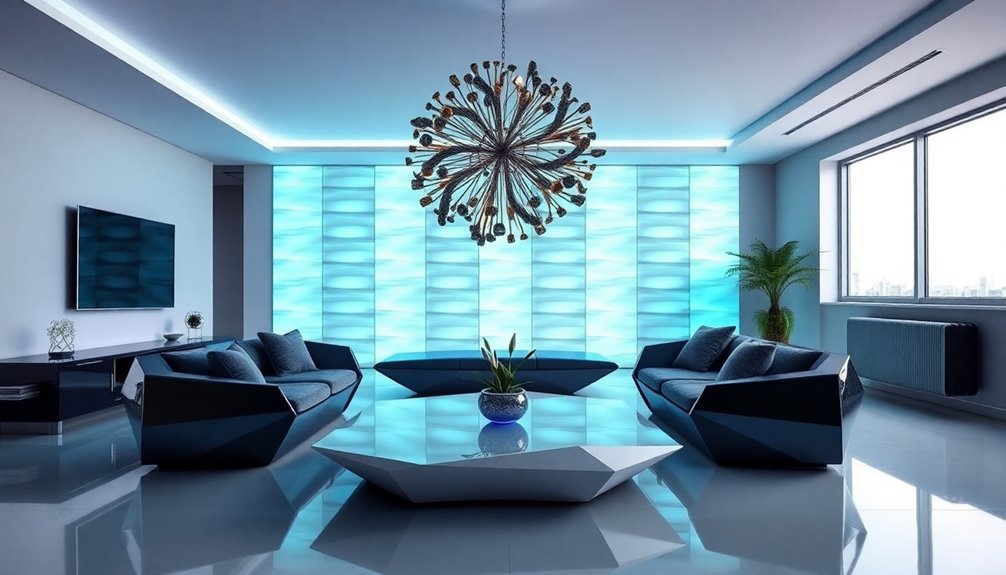
Ultra-modern design offers a range of practical applications that enhance sustainability, comfort, and efficiency in our built environments.
You can benefit from smart building systems that use IoT integration to monitor energy usage, optimizing lighting and temperature for maximum efficiency. Additionally, the incorporation of smart technologies allows for real-time monitoring and automation, further improving energy efficiency and security.
By utilizing sustainable materials like reclaimed wood and natural stone, your spaces won't only look good but also contribute to environmental well-being.
Technologies like BIM and 3D printing streamline construction processes, reducing errors and costs.
With ergonomic layouts and natural elements, you'll create a calming atmosphere that promotes well-being.
Additionally, real-time monitoring and predictive maintenance ensure your building operates at peak performance, making life easier and more enjoyable for you and its occupants.
Cultural and Social Aspects
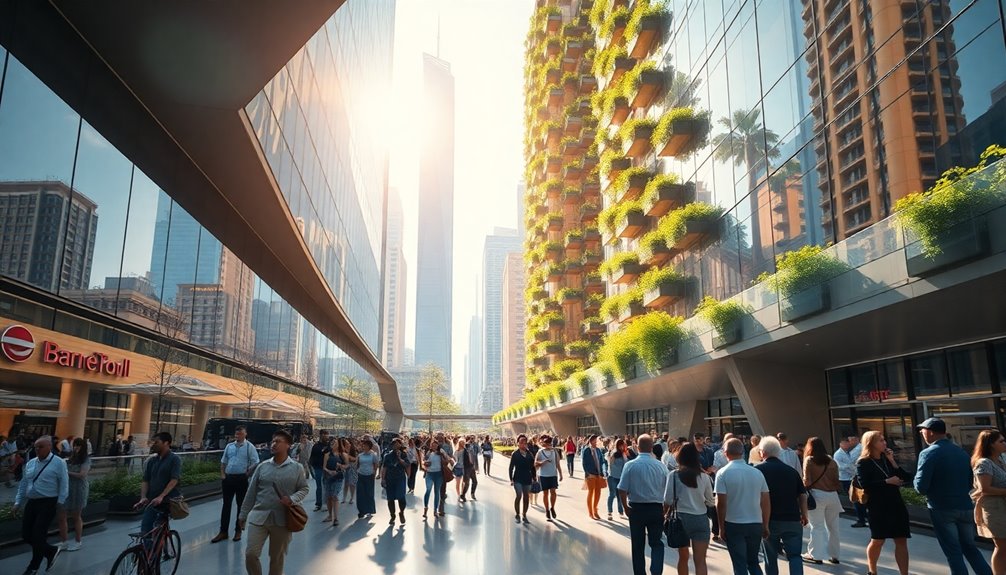
While embracing modernity, architects often weave cultural and social elements into their designs, creating spaces that resonate with community values and traditions. They draw inspiration from historical styles, using local materials and techniques to preserve cultural heritage. This ensures structures reflect the community's identity and aspirations. Additionally, culturally intelligent leaders understand the importance of incorporating local cultural nuances to enhance the relevance of their designs.
Symbolism and spirituality play vital roles, enriching designs with deeper meanings. Cultural heritage serves as a foundation for architectural innovation, providing a rich source of motifs and techniques that inform modern practices.
Globalization fosters cross-cultural exchange, allowing architects to incorporate diverse design elements, celebrating the beauty of different cultures. By adapting traditional elements to meet modern needs, they strike a balance between history and innovation.
Context-driven facade designs, influenced by historical styles and vernacular elements, enhance authenticity. Ultimately, these approaches create a richer, more connected architectural narrative that honors both past and present.
Frequently Asked Questions
How Does Ultra-Modern Design Differ From Contemporary Design?
Ultra-modern design differs from contemporary design primarily in its strict adherence to minimalist principles and high-tech materials.
You'll notice ultra-modern spaces feature sleek lines and bold contrasts, often prioritizing metals and glass.
In contrast, contemporary design is more flexible, constantly evolving with trends and incorporating a mix of natural materials.
This adaptability allows contemporary spaces to blend various styles, while ultra-modern remains focused on a specific aesthetic, reflecting a futuristic vision.
What Are Some Common Misconceptions About Ultra-Modern Design?
Did you know that 70% of people think ultra-modern design is cold and uninviting? That's a common misconception.
In reality, you can incorporate nature and warm materials, creating a cozy atmosphere. Plus, it's not just about high-tech materials; traditional elements like wood and stone can shine through.
You'll also find vibrant colors and textures that add a human touch, making ultra-modern spaces both functional and inviting, not just visually striking.
Can Ultra-Modern Design Be Implemented in Small Spaces?
Absolutely, you can implement ultra-modern design in small spaces.
Focus on maximizing your area with minimalist aesthetics—think clean lines and multifunctional furniture.
Use floating shelves to save floor space and open concept layouts to enhance flow.
Incorporate sustainable materials and smart technology for a contemporary feel.
Finally, embrace lighting tricks to create an airy atmosphere.
With thoughtful choices, your small space can feel both modern and spacious.
What Role Does Color Play in Ultra-Modern Design?
Color plays a vital role in ultra-modern design, influencing mood, aesthetics, and space perception.
You'll find earth tones connecting you to nature, bold hues energizing your environment, and neutrals balancing the overall look.
Incorporating warm woods, vibrant accents, and metallic touches elevates your space.
How Can I Incorporate Ultra-Modern Design on a Budget?
You can incorporate ultra-modern design on a budget by focusing on minimalism.
Choose multifunctional furniture and stick to a neutral color palette. Incorporate natural elements and create DIY decor to add personality without spending much.
Look for second-hand items that you can refurbish. Integrate smart home devices gradually, opt for energy-efficient appliances, and use LED lighting for a sleek look.
These strategies will help you achieve a modern aesthetic without overspending.
Conclusion
In a world where tradition meets innovation, ultra-modern design stands as a bold statement. It captivates with sleek lines and unexpected materials, yet offers comfort in its simplicity. While it pushes boundaries, it also embraces functionality, proving that style doesn't have to sacrifice practicality. As you explore this futuristic aesthetic, you'll find it not only transforms spaces but also sparks conversations, making every corner a blend of art and life. Dive in, and let your imagination soar!
